Bougainvillea is a genus of ornamental vines and shrubs that feature bright, eye-catching blooms, which typically pop out in the winter months, as per the University of Florida’s Gardening Solutions. However, this plant will not thrive in cold and wet regions, much preferring tropical and dry areas of the world. With the proper conditions, this plant grows easily and freely. While most people think of the typical magenta hue when they imagine bougainvillea, you can also find blooms in a wide array of colors, including orange, white, red, and yellow. The neat part about the blooms is that they are not technically flowers — instead, they are known as bracts, which are a type of leaf that surrounds the true flower within. You won’t immediately notice the flower due to its diminished size of about 1 inch and its tendency to stay hidden within the bracts, according to SFGate.
The attraction of the bougainvillea extends beyond its physical beauty. In many cultures around the world, this plant carries deep symbolism. Some believe it is a sign of welcoming visitors while others believe it symbolizes passion within a romantic relationship, as per Exotic Flowers. Many also view the plant as a symbol of peace and good will. No matter the meaning you attribute to bougainvillea, choosing it for your garden will reward you with gorgeous colors and a visual focal point that will draw anyone’s eye. Keep scrolling for everything you need to know about growing and caring for bougainvillea.
How to use bougainvillea in garden
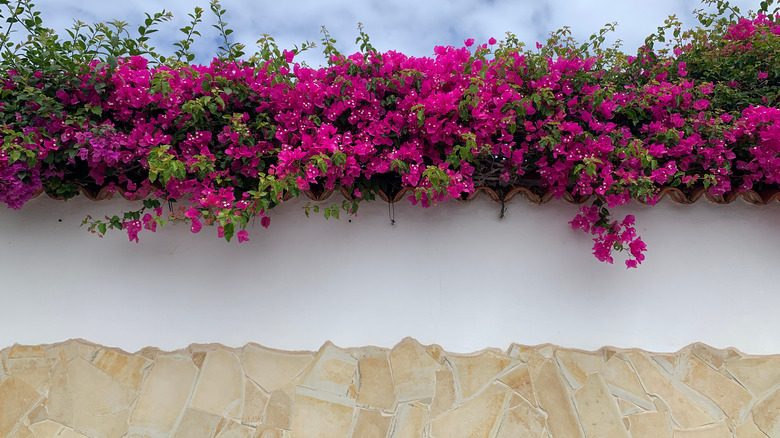
Bougainvillea offers many possible design options for use in garden settings. Due to its nature to grow like a vine, you can plant bougainvillea along garden walls and the side of your house to encourage it to sprawl across the surface and truly become a focal point of your outdoor space, as per Garden Design. Note that you may need to set up trellises to make sure your bougainvillea grows the way you want it to. Additionally, if there are fissures present on the exterior of your home, the vines can make their way inside and potentially cause harm to the structural components. Bougainvillea is a popular choice to plant along the top of a fence due to its tendency to grow thorns. Instead of a barbed-wire security fence, you will have a much more visually attractive alternative that will keep away unwanted visitors.
You can also grow smaller varieties of bougainvillea in containers if you aren’t a fan of the larger varieties. Containers are a versatile option as they can be placed anywhere in your outdoor space and can be moved around. This is a great choice for anyone who lives in frost-prone regions during the winter as you can bring your bougainvillea indoors during the colder months without risk of it dying. One other way to use bougainvillea in your garden is to plant it as ground covering in an unused area of your yard.
How to grow bougainvillea
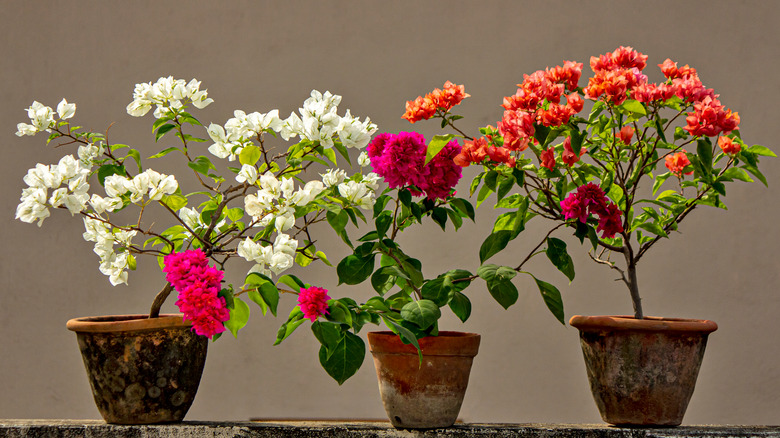
Bougainvillea is typically planted from a root ball, which you can buy at your local plant nursery, as per Joy Us Garden. To get started planting your bougainvillea, you will need a shovel and some organic compost. You will begin by digging holes double the depth and width of the root ball. The soil should also be tilled at the base and along the sides of the hole to ensure proper water drainage.
It is important that you do not remove the root ball from its growth pot before planting it in the ground as this will upset the plant. However, you must make cuts around the circumference and at the bottom of the pot to allow the roots to extend into the surrounding soil. Before filling in the rest of the hole with soil, make sure that the root ball is not placed too deep in the earth nor that it extends above the top of the soil line. Once the hole is filled, spread some compost over the top for some added nutrition. You will need to water generously in the beginning until your bougainvillea is well-established in its new home.
If you prefer planting in a container, choose a dwarf variety of bougainvillea and a pot with good drainage, as per Gardening Know How. Place the root ball in the pot and fill with an organic potting mix. Note that pot-bound bougainvilleas will need more frequent waterings even after getting established.
How to care for bougainvillea
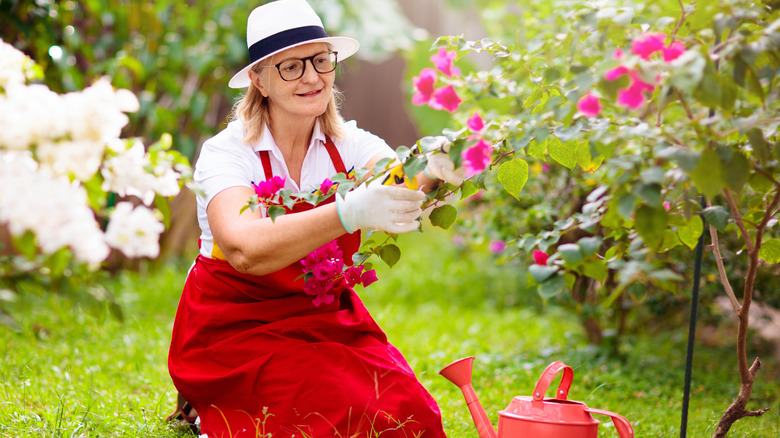
FamVeld/Shutterstock
In addition to preferring warm climates, bougainvillea is a sucker for sunshine, as this is the key to its beautiful blooms. If you live in USDA planting zones 9 through 11, you shouldn’t have a problem getting your bougainvillea to thrive in your garden, as per The Spruce. However, if you live outside these zones and experience cold winters, consider planting your bougainvillea in pots and bringing them into your home or placing them in a greenhouse until the threat of frost passes.
Aside from plenty of direct sunlight during the day, you will also need to ensure that your bougainvillea is planted in well-draining soil. While naturally drought resistant, this plant does better with regular waterings, according to Garden Design. However, you will want to make sure you allow the soil adequate time to dry out before giving more water as this will prevent root rot and other over-watering issues. You can tell if you’ve given enough water because there will be a balance of bracts and leaves, which means not too much green nor too much color. You will also need to help your bougainvillea achieve its nutritional needs by supplying it with a slow-release fertilizer throughout the growing season. The final care tip for ensuring your bougainvillea is a happy camper in your garden is to prune regularly as blooms grow. Not only does this allow you to shape the plant, it also encourages further growth.
Varieties of bougainvillea
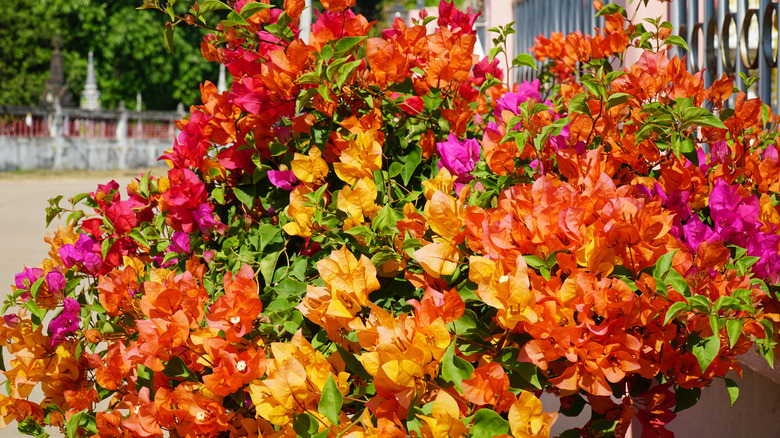
KPhrom/Shutterstock
Bougainvillea (scientific name: bougainvillea) is a genus boasting more than 250 varieties, as per Pro Flowers. Among the different sub-groups of bougainvillea are dwarf, giant, thornless, and semidwarf. This plant hails originally from South America and it was discovered in the 18th century by the French navigator, Louis Antoine de Bougainville, as per KCET. Following his expedition to Brazil, bougainvillea soon spread to the rest of the world. The plant has been cultivated and hybridized ever since, and now features a wide variety of sizes and bloom colors. The smallest varieties grow between 3 and 6 feet tall while the larger varieties can reach heights of 30 feet, according to Garden Lovers Club. Many people enjoy mixing and matching the different-colored bracts in their gardens, choosing from magenta, orange, yellow, red, white, and pink.
Among the many varieties is the California Gold, which delights growers with its pale-yellow blooms and tendency to reach heights of 30 feet, shared Better Homes & Gardens. Another popular variety is Sundown Orange, which stays true to its name with its gorgeous orange hues. If you prefer the magenta-colored bracts more typical of this plant, you’ll want to go for the Barbara Kast, which will cover your garden in 40-foot vines. For a smaller variety that’s perfect for container growth, go for the Sunvillea Cream, which features white blooms, as per Garden Lovers Club. The Helen Johnson is another candidate for the container life, reaching a mere 3 feet in height.
Is bougainvillea toxic?
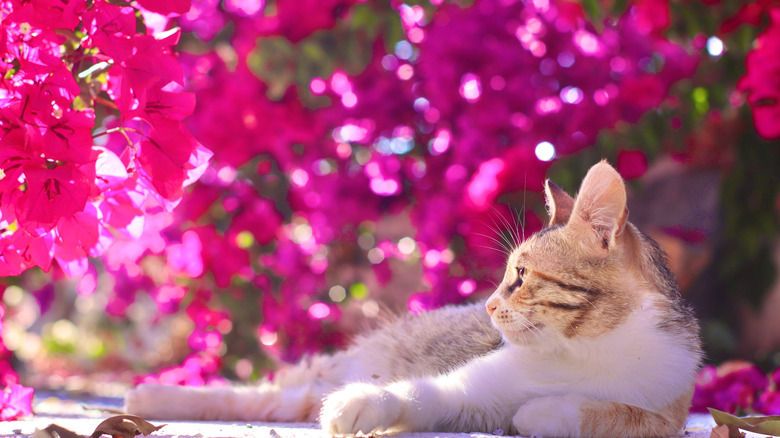
kubra cavus/Shutterstock
Bougainvillea is not one of the most toxic plants in existence that you have to worry about if you have young children or pets that like to chew on or ingest the plants and flowers in your garden. The sap of the plant is the only part that can cause any type of toxicity symptoms when ingested, as per SFGate. These symptoms may range from vomiting to diarrhea and general stomach upset. However, consuming a small amount of sap likely won’t cause any harm. If symptoms are present, it is best to contact your nearest emergency hospital for immediate treatment.
While only mildly toxic if ingested, you will need to pay careful attention to bougainvillea’s many thorns. An accidental scratch can lead to dermatitis, which is a fancy term for skin irritation. However, the symptoms of dermatitis caused by the bougainvillea thorn are not pleasant and can include swelling, blisters, and itching. You should take care to wear gloves and long sleeves when handling your bougainvillea to avoid getting pricked. If you do show signs of dermatitis, you should seek medical attention as you may need to treat the affected area with a specialized ointment.
Keeping your pets away from potentially harmful plants may seem like an impossible mission, but the good news is that they are unlikely to spend too much time investigating your bougainvillea due to its thorns. However, in the case of accidental pricks or ingestion, contact your veterinarian for assistance.
How to repot bougainvillea
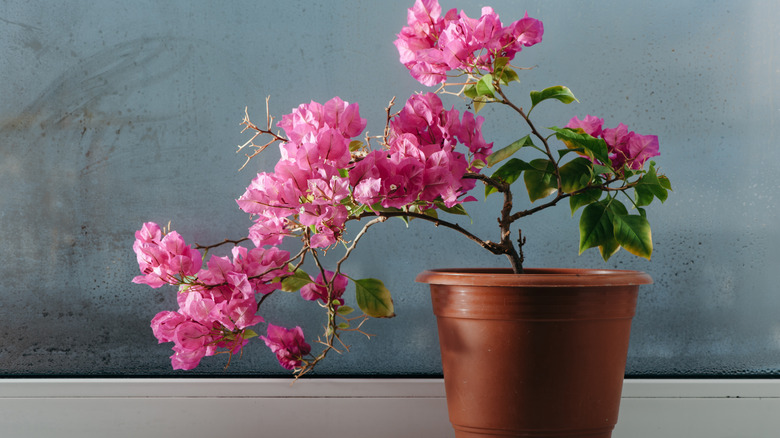
daniilphotos/Shutterstock
Even though you can plant dwarf varieties of bougainvillea successfully in pots and containers, there will come a time when they will need to be repotted due to excessive growth — typically every spring. You will be able to tell that your bougainvillea is in need of a larger container when the roots start growing out of the drainage holes and when growth seems to stall even when all other growing conditions are accounted for. There are two ways of repotting a bougainvillea: You can either buy a new container one size larger than the current one or reduce the size of the root ball and replant it in the same pot, according to SFGate.
If you opt to purchase a larger-sized container, simply add a base layer of potting soil to the container, place the root ball on top, then fill in the rest with soil. Just take care to remove the root ball gently from the old pot when moving it to the new one. If you prefer to reduce the size of the root ball, you will need an extra-sharp knife that has been disinfected. Carve around 1 to 2 inches of the ball off all sides, making sure to cut the bottom as well. Then wash out the old container and complete the potting steps as usual. In both cases, you will need to water generously while your bougainvillea gets used to its new home.
Bougainvillea pests and diseases
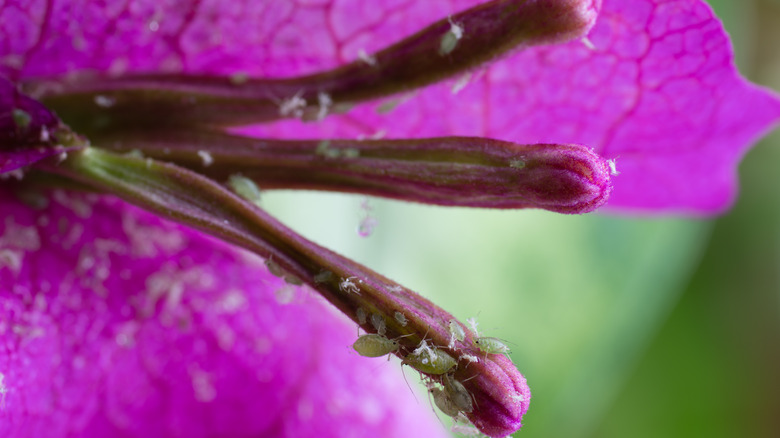
Floki/Shutterstock
Bougainvillea is susceptible to a variety of pests and diseases that can jeopardize its health and survival. Green aphids are this plant’s top predator. This insect likes to eat the various parts of the plant and can do excessive damage in large quantities, as per Topiary Creations. While small in size, you can normally spot this pest on the blooms, leaves, and stems of your bougainvillea. You can remove them by hand or use chemical products, such as neem oil, insecticidal soap, and insecticides in extreme cases. Make sure to dispose of any damaged areas of the plant once the infestation is under control. Other pests that tend to target bougainvillea are spider mites, thrips, and slugs and snails. You can use the same methods to get rid of these pests as well.
Among the diseases that can infect and harm your bougainvillea is fungal and bacterial leaf spot, according to eHow. Just as its name suggests, this disease will alert you to its presence with brown spots and stains along the leaves. As the disease worsens, it will cause the leaves to die and fall off. The main causes are excessive moisture and lack of air flow. If your bougainvillea is growing too densely, you will need to cut it back to allow for better air circulation. To treat the disease once it starts, spray a fungicide over the entire plant and dispose of any infected parts.



